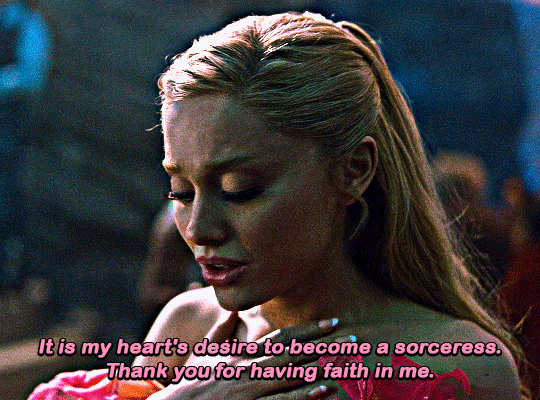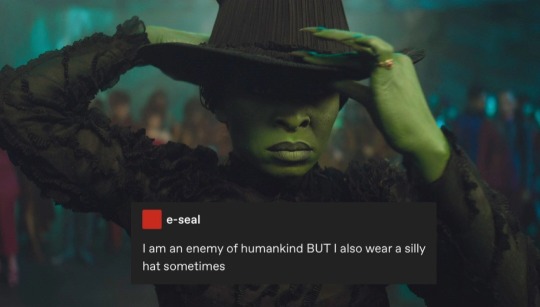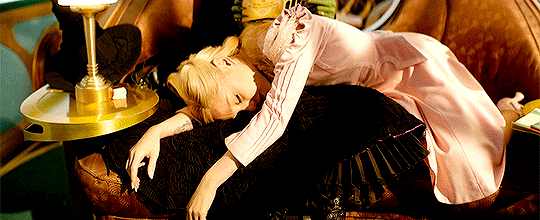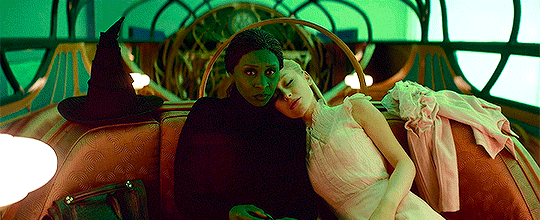katherinemckay
262 posts
cass :)menace to the gelphie tag
Don't wanna be here? Send us removal request.
Text
random glinda rant of the day bc im still stuck on the way ari looked in defying gravity and her subsequent thoughts on that moment:
I understand that, in the context of the musical, Glinda makes several very poor choices of her own free will in Act 2. However - I also firmly believe that Glinda not leaving with Elphie in Defying Gravity is not as simple as her just “not wanting to go against the system.” Is that a part of it? Certainly. Is that all or even most of it? imo No.
As Ariana herself said: Glinda would’ve died if she left. There was no way both girls were flying out of there. Plus, Glinda’s whole world just got turned upside down, she just got chased by flying monkeys and almost fell to her death, her best friend was labeled an enemy of the State, guards are trying to kill them, the ruler of Oz is apparently a liar, like- these are crazy things to process in the moment! And then to expect her to get on a rickety broom and trust that it can carry her away???
Also- where would they go?! Elphie had no plan. Glinda had no plan. If they left, all Glinda knew was that they’d be on the run from people trying to kill them and she has no power. She can contribute absolutely nothing. People forget, she wasn’t Glinda the Good yet. She was just a random college student. Like I genuinely don’t think Glinda was over here thinking “oh no, i won’t be popular anymore” like the girl was probably thinking “shit what if we die?!”
(also: imagine your best friend, who the leader of your country has a personal vendetta against, pulled you to the edge of a building and was like “we’ve got one parachute, and i’m going to wear it, and i’ve never used a parachute before, but don’t worry- i think i can catch you”)
#!!!!!! there are So many factors at play in glinda's decision it's so much more than just one thing#the stakes were so high and elphaba's planned seemed (to glinda) incredibly impulsive and not thought out#love the example at the end - putting yourself in glinda's shoes makes her decision seem very reasonable
267 notes
·
View notes
Text
i don't like when people reduce glinda's decision to stay behind into one simple thing, when there are so many moving parts that contribute to why she didn't go with elphaba
on one hand, she's scared and she hasn't reached the part of her character developement where she's ready to stand up to authority like that. part of her recognizes that staying with the wizard will be personally beneficial, and she's willing to make moral compromises for her own gain
but she's not being entirely selfish, either. she's actually primarily concerned about elphie. glinda recognizes the dangers of rebelling against the wizard like that, and doesn't want elphaba to get hurt. glinda genuinely believes that if elphie stays behind, puts her head down, and plays the game, she'll be able to further her cause more than outright rebellion
part of this belief probably comes from the fact that staying with the wizard is the easier thing to do, but glinda's also still naive about how the system works. she's only ever benefitted from the status quo, so she believes that change can still occur within the system. even while they're literally being chased by the gale force, glinda is like "if you say you're sorry, we can fix this"
and i think her role as glinda the good is complicated, too. like, on one hand, glinda knows the truth about the wizard, so she kind of has to play this role for her own safety. but it's clear she also enjoys the attention and praise she gets by being "glinda the good," which is why she doesn't go find elphaba like fiyero suggests
but i also think glinda believes that she's doing good as "glinda the good." like, she's making people happy and bringing them much needed joy in uncertain times. she's trying to promote kindness and charity. obviously, this ignores the fact that she's complicit in the wizard's rule, but her character development in act ii is her deciding to be truly good and stand up to that system
glinda genuinely wants to be a good person and do good, and her character arc is her learning how to do that
idk this is probably just rambling but i get bothered when ppl reduce glinda's decision to her being selfish or not loving elphie enough. she's way more complicated than that and i think that's what makes her so interesting
352 notes
·
View notes
Text
one musical to movie change i haven't really seen anyone talk about is the subtle difference in how glinda's potential future with the wizard is laid out to her before defying gravity (and how that changes how you can read her motivations).
in the musical the wizard explictly says "you have so many opportunities ahead of you - you both do" and then that's that, so glinda has reason to believe she has a legitimate future with the wizard regardless of whether elphaba's there. this can play into the interpretation that she stays behind for her own ambitions - she clearly has opportunities waiting for her.
however, this actually isn't how it comes across in the movie, at least to me. the wizard's original inclusion of glinda in his plans is changed from explicitly mentioning opportunity to just "you having a home here [...] and if it'll make you happy, possibly, your friend." in the movie version, the wizard directly states only that glinda would be joining them in the palace - and it's merely a suggestion as an addition to elphaba (she's even just referred to as her friend, not being spoken directly to) to make elphaba want to stay, rather than him describing glinda as someone who could have her own individual opportunities.
then, when elphaba runs away, morrible tells glinda "you want to do yourself some good, bring her back." here, morrible now suggests that glinda could do something for herself and her individual future. what i find interesting is that glinda instead jumps on the hot air balloon with elphaba and even fights off the guards with her. while glinda does try to talk elphaba down for awhile ("let's just have a word with them," "you've got to let him explain," etc.), she ultimately abandons this approach by the time elphaba has chosen to defy gravity.
in the movie, glinda goes against morrible's direct orders of bringing elphaba back when she accepts elphaba's choice to leave and helps her get ready. this means that by supporting elphaba in her decision, glinda actually abandons the chance she believes she has to finally get in with morrible (and by extension the wizard). in movie-verse, glinda really has no reason to believe staying behind without elphaba could advance her own ambitions, because both the wizard and morrible have laid out a potential future for her that is reliant on having elphaba at her side and keeping elphaba compliant to them (and using glinda to do that). i don't think that movie!glinda ultimately stays behind for selfish/power-seeking reasons, because the wizard and morrible haven't actually suggested to her that she has a path alongside them as an individual. (they also just truly show no interest in glinda as an individual person in a much more obvious way than in the musical, but that could be its own post.)
ariana grande has spoken a couple times on how one of the emotions glinda feels in the added hug scene with morrible is relief, and i think this all is why. glinda chose to stay behind while helping elphaba escape, knowing it was disobeying what was asked of her. given glinda is also being detained by the guards in that moment, i think that relief comes from her genuinely not having known if she would be safe or would become essentially a prisoner after staying behind, and feeling relief when morrible does free/accept her and suggests there's still a path for her.
there's definitely moral grayness to discuss with how glinda accepts her position within the regime and settles into it, but i think (in movie-verse) the actual choice to stay behind isn't one of those moments — it wasn't established to glinda that staying behind without elphaba could actually lead her to power and opportunity with the wizard, and she directly goes against the one path to power that was suggested to her by helping elphaba leave.
#wicked analysis#does this essay have a point? unclear tbh#but it's something i've been thinking about a lot especially when people discuss glinda's motivations#bc i don't actually see movie!glinda as being selfish in this specific moment#gelphie#kinda#wicked#wicked movie
292 notes
·
View notes
Text




glinda telling elphie about "the mustache man"
+ the mustache man

895 notes
·
View notes
Text





My personal opinion, dear, is that you do not have what it takes. I hope you prove me wrong. I doubt you will.
306 notes
·
View notes
Text








"I could care less..."
838 notes
·
View notes
Text


WICKED (2024) — dir. Jon M. Chu
2K notes
·
View notes
Text



appreciation post for the tiny characterization details in glinda and elphaba's letters:
- glinda having her own personalized printed stationary, elphaba just using a loose sheet
- elphaba writing in a practical print that's a little messy because she's just focused on getting down the message, glinda writing in clean cursive because she's all about the aesthetic (sets up "form over content" well)
- elphaba properly indenting the letter, glinda having pretty inconsistent paragraph spacing
- even when it comes to the pens, glinda's is fancier while elphaba's looks more generic. everything glinda has is personalized to herself and her aesthetic, while elphaba is likely used to not having anything catered to her personally
#screencapped for twitter for fun then thought why not make some Observations#my fav thing abt films is how every little detail when it comes to character design/props/etc reveals something#wicked movie#gelphie#wicked#wicked analysis
178 notes
·
View notes
Text

83 notes
·
View notes
Text
glinda running away screaming and crying and then standing against the wall and closing her eyes and waiting for death... elphaba saw firsthand how much of a TERRIBLE fugitive glinda would've been and was still like mmm yes please come with me we'll be the greatest team there's ever been. she loves glinda so dearly.
850 notes
·
View notes
Text
something my brain has been thinking over is how the wizard having no powers basically shatters elphaba's worldview, but it actually reinforces glinda's in a lot of ways? like it essentially proves her thesis of "it's not about aptitude, it's the way you're viewed" / "did they have brains or knowledge? they were popular" etc. so to me it makes sense that she would be frustrated at elphaba's approach, because in glinda's eyes, it was just confirmed that the only way power is maintained in their society is through perception & image. i think the wizard has confirmed for her that perception has more impact than actual aptitude/skill, so she sees elphaba's approach as 'hurting her cause forever' even though elphaba does have more actual power and ability than the wizard.
elphaba does a 180 to breaking outside of the system because her belief in it has just crumbled, so she sees no value in adhering to it and trying to play by its broken rules. but glinda doubles down on staying inside, because its very flaws have actually further convinced her there's not a realistic path outside of it. interesting stuff
#ive been putting all my recent wicked thoughts on twitter but this felt too long for that outlet#so we're back to my roots#wicked analysis#gelphie#kinda?
1K notes
·
View notes
Text
ariana grande: it was the first day of wicked rehearsals. i was wearing a pink hoodie that said 'GAY'. glinda might be a little in the closet. i'm in queer media. oz is very queer. everyone in oz is queer, even the chickens. those chickens are gay. dr dillamond is a gay icon. let's talk about it! 'the boy is mine' could have a wicked version. but is it about elphaba? i'm just saying...
577 notes
·
View notes
Text


Wicked (2024) Directed by Jon M. Chu
170 notes
·
View notes















